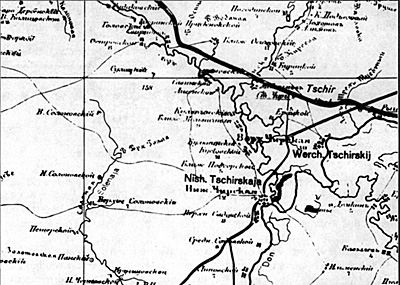 December 1942: the German Sixth Army was cut off in
Stalingrad. Soviet forces drove westward, attempting to exploit the
huge hole in the Axis line. To the west of Stalingrad, the Soviet 5th
Tank Army attacked across the Chir River, attempting to push the
German forces further back towards their vital bottleneck at Rostov.
Defending the Chir were the 11 th Panzer Division and several infantry
formations under command of 48th Panzer Korps.
December 1942: the German Sixth Army was cut off in
Stalingrad. Soviet forces drove westward, attempting to exploit the
huge hole in the Axis line. To the west of Stalingrad, the Soviet 5th
Tank Army attacked across the Chir River, attempting to push the
German forces further back towards their vital bottleneck at Rostov.
Defending the Chir were the 11 th Panzer Division and several infantry
formations under command of 48th Panzer Korps.
In six days of mobile battle the Germans barely managed to hold the river line and roughly handled two Soviet corps. The Battles on the Chir River later would be cited in many history texts as examples of masterful mobile warfare in the face of imposing odds. But this tactical victory was bought at the price of losses the Germans could not afford; the severe casualties prevented 11th Panzer from joining the relief attack towards Stalinegrad.
48th Panzer Korps simulates these tense days along the Chir River. The game emphasizes weapon type interactions in a mobile setting. In combat, units fire at one another; weapon and target types determine effectiveness. For example, infantry units are feeble against armor, but deadly against unprotected guns. Target priority rules determine which units must be fired upon, so that armor units can protect personnel and personnel can protect artillery. Each weapon needs the support of the others.
Morale is critical; units with strong morale can remain in place or press home an attack despite heavy losses, while units with weak morale may have to retreat immediately. Players have options of retreating or attempting to stand in place.
The sequence of play highlights the distinction between mobile and set-piece combats. Players have the choice between coordinating multiple stacks in "prepared combat" - after which units can move half the normal distance at most - or fighting with individual stacks in "mobile combat", which also allows full movement. The right combination of power (prepared combat) and movement (mobile combat) is essential to victory for either side.
To provide background, Dr Russel Stolfi discusses the Chir River battles which provide the context for 48th Panzer Korps and General Otto von Knobelsdorf provides insights into the command problems of the 48th Panzer Corps with his debriefing by the US Army after the war in 'Reverses on the Southern Wing'.
Also coming in CounterAttack 3: John Prados discusses the fighting 'To Save Dien Bien Phu' and reveals some interesting material on the final military phase of the French Indo-China War and how the US nearly became involved - even to the point of employing atomic weapons.
The Frog-bashing continues with Mike Joslyn's description of the most vicious conflict of this century: the Algerian War. This one had everything: Christian versus Moslem, French versus Arabs, African French versus European French, the French Army Versus the French Government, communists versus de Gaulle, de Gaulle versus the French Army; two military revolts, assassination, riot, torture, the invasion of Corsica....
In a new feature, 'FORUM', Major Donald Alexander rebuts Owen Stanley's 'Soviet Conventional Combat Philosophy' in the sectors of policy, economics of technology, ratios of numbers to victory, and the will to win. In another new feature, 'PAGES', books of interest are critically reviewed.
Back to Table of Contents: CounterAttack # 2
To CounterAttack List of Issues
To MagWeb Master Magazine List
© Copyright 1988 by Pacific Rim Publishing Company.
This article appears in MagWeb (Magazine Web) on the Internet World Wide Web.
Other articles from military history and related magazines are available at http://www.magweb.com